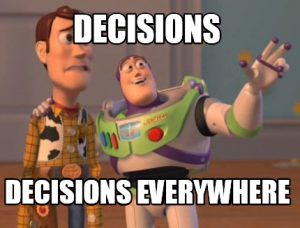As we move toward an increasingly digital world, one has to wonder about the place of print material in the school library learning commons. Are they still relevant? Should we be spending money on them?

In my opinion, the answer is a big YES. While I have to admit I am biased and personally prefer print to digital material, the fact of the matter is that students still greatly benefit from hard copies of books, magazines, journals, and other resources.
In her article Being a Better Online Reader, Maria Konnikova explains that reading online and reading print material are very different experiences. Online reading encourages skimming “as a way of coping with an overload of information” (Konnikova, 2014). This brings up another important issue with online material: the enormous quantity of (often irrelevant) information available on the Internet. The Internet is a powerful tool when used appropriately. However, it can also be a frustrating and confusing tool for students who are not digitally literate. As a result, the school library learning commons needs to offer both print and digital resources to allow students to develop a range of reading, information, and digital literacy skills.
This is where the teacher-librarian’s expertise in selecting resources comes into play. There are many questions to consider when evaluating resources. While the question of format (electronic or print) is an important one, there are also questions of purpose, scope, authority, accuracy, currency, and cost to consider. Since the reference collection covers a wide range of disciplines and materials, there is no absolute standard to consider when evaluating a learning resource. Rather, the teacher-librarian must evaluate each resource individually, thus making “building a library collection [an] ongoing activity” (Riedling & Houston, 2019, p. 19).
Theme 3 of LIBE 467 covered evaluating different types of reference resources such as encyclopedias, databases, indexes, dictionaries, and many more. The module I found the most interesting was “Digital Resources, the Web, and Grey Literature”. Thanks to the readings in this module, I gained a deeper knowledge of the “hidden” areas of the Internet. I was also able to realise how important it is to teach students how to access and use resources other than Google for their research queries. I didn’t learn how to access databases and online journals until university when I signed up for a workshop at my university’s library. I do think I could have greatly benefited from this knowledge earlier in my schooling.
To conclude, students today need to learn to navigate both the print and digital world. This means that libraries need to provide learning opportunities in both mediums so that students feel comfortable accessing, evaluating, and interpreting information in a wide variety of formats. To conclude, print and digital resources and media complement each other. In the following TED Talk, Leandrea Adelaine Louw explains how print media has evolved in the digital age to remain relevant, authentic, accurate, and engage with readers through social media.
Bibliography
Konnikova, M. (2014, July 16). Being a Better Online Reader. Retrieved from The New Yorker: https://www.newyorker.com/science/maria-konnikova/being-a-better-online-reader
Riedling, A. M., & Houston, C. (2019). Reference Skills For The School Librarian: Tools and Tips Fourth Edition. Santa Barbara: Libraries Unlimited.
TEDx Talks. (2019, September 18). Can Print Media Survive the Digital Age | Leandrea Adelaine Louw | TEDxSwakopmund . Retrieved from YouTube: https://www.youtube.com/watch?v=EPaAmWdjT-0